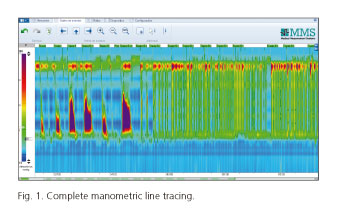My SciELO
Services on Demand
Journal
Article
Indicators
-
 Cited by SciELO
Cited by SciELO -
 Access statistics
Access statistics
Related links
-
 Cited by Google
Cited by Google -
 Similars in
SciELO
Similars in
SciELO -
 Similars in Google
Similars in Google
Share
Revista Española de Enfermedades Digestivas
Print version ISSN 1130-0108
Rev. esp. enferm. dig. vol.109 n.8 Madrid Aug. 2017
https://dx.doi.org/10.17235/reed.2017.4887/2017
LETTERS TO THE EDITOR
Two types of achalasia in the same patient. Is this really the case? An unusual finding in a single study
¿Dos tipos de acalasia en un mismo paciente? ¿Realmente es así? Un caso infrecuente de objetivar en el mismo estudio
Key words: Achalasia. High-resolution manometry.
Palabras clave: Acalasia. Manometría de alta resolución.
Dear Editor,
A patient presented with dysphagia and a high-resolution manometry (HRM) study was performed that revealed two types of achalasia in a single trace.
We present the case of a 31-year-old woman with mixed dysphagia. All tests were normal with the exception of HRM. Sixteen swallows were analyzed: ten were simultaneous contractions with panesophageal pressurization and a distal contractile integral (DCI) < 8,000 mmHg. The other six showed rapid premature contractions with a DCI > 8,000 mmHg.
The Chicago Classification (CC) recognizes three types of achalasia. Our patient presented findings in the same study that corresponded to two of the three achalasia types, type II and type III. This is uncommon.
In 2008, Pandolfino (1) reported a retrospective analysis of HRM studies performed in 1,000 patients. Achalasia was identified in 99 cases. Some of these patients showed different findings in the same trace. Two hundred and ninety swallows were analyzed in type III patients, of which 10.3% were simultaneous contractions and 80% were spastic. Analysis of the first ten contractions in our patient showed that six were spastic. What might explain this variation in traces in a single study? Multiple rapid swallowing (2) may be a useful test for determining the presence of simultaneous contractions. According to the CC, the presence of at least one spastic contraction is diagnostic of type III achalasia. Type I and II may be the same entity in different stages of development, whilst type III is a heterogeneous entity that also differs from the other two in terms of esophageal wall histology (3).
It seems that achalasia types are neither watertight compartments nor independent structures (I and II are similar, whilst III is very different).
Our findings raise the following questions: Is the analysis of only ten swallows sufficient to make a definitive classification of achalasia type? What factors affect the appearance of different patterns of esophageal contraction in the same achalasia patient?.
José Miguel Alonso-Rivero1 and Néstor Alemán-Pérez2
1Department of Gastroenterology. Hospital Universitario de Gran Canaria
Dr. Negrín. Las Palmas de Gran Canaria, Spain.
2Department of Gastroenterology. Hospital Dr. José Molina Orosa.
Lanzarote, Spain
References
1. Pandolfino JE, Kwiatek MA, Nealis T, et al. Achalasia: A new clinically relevant classification by high resolution manometry. Gastroenterol 2008;135:1526-33. DOI: 10.1053/j.gastro.2008.07.022. [ Links ]
2. Kahrilas PJ, Bredenoord DJ, Fox M, et al. The Chicago Classification of esophageal motility disorders, v3.0. International High Resolution Manometry Working Group. Neurogastroenterol Motil 2015;27(2):160-74. DOI: 10.1111/nmo.12477. [ Links ]
3. Kahrilas PJ, Boeckxstaens G. The spectrum of achalasia: Lessons from studies of pathophysiology and high-resolution manometry. Gastroenterol 2013;145(5). DOI: 10.1053/j.gastro.2013.08.038. [ Links ]














